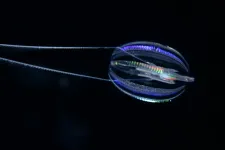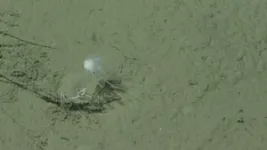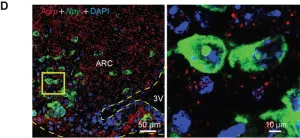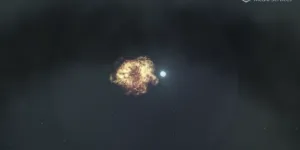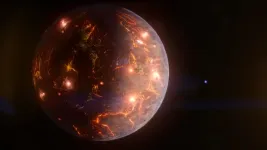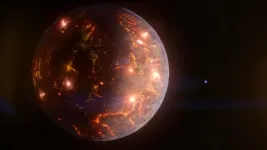(Press-News.org) For more than a century, biologists have wondered what the earliest animals were like when they first arose in the ancient oceans over half a billion years ago.
Searching among today's most primitive-looking animals for the earliest branch of the animal tree of life, scientists gradually narrowed the possibilities down to two groups: sponges, which spend their entire adult lives in one spot, filtering food from seawater; and comb jellies, voracious predators that oar their way through the world's oceans in search of food.
In a new study published this week in the journal Nature, researchers use a novel approach based on chromosome structure to come up with a definitive answer: Comb jellies, or ctenophores (teen'-a-fores), were the first lineage to branch off from the animal tree. Sponges were next, followed by the diversification of all other animals, including the lineage leading to humans.
Although the researchers determined that the ctenophore lineage branched off before sponges, both groups of animals have continued to evolve from their common ancestor. Nevertheless, evolutionary biologists believe that these groups still share characteristics with the earliest animals, and that studying these early branches of the animal tree of life can shed light on how animals arose and evolved to the diversity of species we see around us today.
"The most recent common ancestor of all animals probably lived 600 or 700 million years ago. It's hard to know what they were like because they were soft-bodied animals and didn't leave a direct fossil record. But we can use comparisons across living animals to learn about our common ancestors," said Daniel Rokhsar, University of California, Berkeley professor of molecular and cell biology and co-corresponding author of the paper along with Darrin Schultz and Oleg Simakov of the University of Vienna. "It's exciting — we're looking back deep in time where we have no hope of getting fossils, but by comparing genomes, we're learning things about these very early ancestors."
Understanding the relationships among animal lineages will help scientists understand how key features of animal biology, such as the nervous system, muscles and digestive tract, evolved over time, the researchers say.
“We developed a new way to take one of the deepest glimpses possible into the origins of animal life,” said Schultz, the lead author and a former UC Santa Cruz graduate student and researcher at the Monterey Bay Aquarium Research Institute (MBARI) who is now a postdoctoral researcher at the University of Vienna. “This finding will lay the foundation for the scientific community to begin to develop a better understanding of how animals have evolved.”
What's an animal?
Most familiar animals, including worms, flies, mollusks, sea stars and vertebrates — and including humans — have a head with a centralized brain, a gut running from mouth to anus, muscles and other shared features that had already evolved by the time of the famed “Cambrian Explosion” around 500 million years ago. Together, these animals are called bilaterians.
Other bona fide animals, however, such as jellyfish, sea anemones, sponges and ctenophores, have simpler body plans. These creatures lack many bilaterian features — for example, they lack a defined brain and may not even have a nervous system or muscles — but still share the hallmarks of animal life, notably the development of multicellular bodies from a fertilized egg.
The evolutionary relationships among these diverse creatures — specifically, the order in which each of the lineages branched off from the main trunk of the animal tree of life — has been controversial.
With the rise of DNA sequencing, biologists were able to compare the sequences of genes shared by animals to construct a family tree that illustrates how animals and their genes evolved over time since the earliest animals arose in the Precambrian Period.
But these phylogenetic methods based on gene sequences failed to resolve the controversy over whether sponges or comb jellies were the earliest branch of the animal tree, in part because of the deep antiquity of their divergence, Rokhsar said.
"The results of sophisticated sequence-based studies were basically split," he said. "Some researchers did well-designed analyses and found that sponges branched first. Others did equally complex and justifiable studies and got ctenophores. There hasn’t really been any convergence to a definitive answer."
Just looking at them, sponges seem quite primitive. After their free-swimming larval stage, they settle down and generally remain in one place, gently sweeping water through their pores to capture small food particles dissolved in sea water. They have no nerves or muscles, though their hard parts make nice scrubbers in the bath.
"Traditionally, sponges have been widely considered to be the earliest surviving branch of the animal tree, because sponges don't have a nervous system, they don't have muscles, and they look a little bit like colonial versions of some unicellular protozoans," Rokhsar said. "And so, it was a nice story: First came the unicellular protozoans, and then sponge-like multicellular consortia of such cells evolved and became the ancestor of all of today’s animal diversity. In this scenario, the sponge lineage preserves many features of the animal ancestor on the branch leading to all other animals, including us. Specializations evolved that led to neurons, nerves and muscles and guts and all those things that we know and love as the defining features of the rest of animal life. Sponges appear to be primitive, since they lack those features."
The other candidate for earliest animal lineage is the group of comb jellies, popular animals in many aquariums. While they look superficially like jellyfish — they often have a bell-like shape, although with two lobes, unlike jellyfish, and usually tentacles — they are only distantly related. And while jellyfish squirt their way through the water, ctenophores propel themselves with eight rows of beating cilia arranged down their sides like combs. Along the California coast, a common ctenophore is the 1-inch-diameter sea gooseberry.
Chromosomes to the rescue
To learn whether sponges or ctenophores were the earliest branch of animals, the new study relied on an unlikely feature: the organization of genes into chromosomes. Each species has a characteristic chromosome number — humans have 23 pairs — and a characteristic distribution of genes along chromosomes.
Rokhsar, Simakov and collaborators had previously shown that the chromosomes of sponges, jellyfish and many other invertebrates carry similar sets of genes, despite more than half a billion years of independent evolution. This discovery suggested that chromosomes of many animals evolve slowly, and allowed the team to computationally reconstruct the chromosomes of the common ancestor of these diverse animals.
But the chromosome structure of ctenophores was unknown until 2021, when Schultz — then a graduate student at UC Santa Cruz — and his co-advisers, Richard Green of UCSC and Steven Haddock of MBARI and UCSC, determined the chromosome structure of the ctenophore Hormiphora californiensis. It looked very different from those of other animals, which posed a puzzle, Rokhsar said.
"At first, we couldn’t tell if ctenophore chromosomes were different from those of other animals simply because they’d just changed a lot over hundreds of millions of years,” Rokhsar explained. “Alternatively, they could be different because they branched off first, before all other animal lineages appeared. We needed to figure it out."
The researchers joined forces to sequence the genomes of another comb jelly and sponge, as well as three single-celled creatures that are outside the animal lineage: a choanoflagellate, a filasterean amoeba and a fish parasite called an ichthyosporean. Rough genome sequences of these non-animals already existed, but they did not contain the critical information needed for chromosome-scale gene linkage: where they sit on the chromosome.
A smoking gun
Remarkably, when the team compared the chromosomes of these diverse animals and non-animals, they found that ctenophores and non-animals shared particular gene-chromosome combinations, while the chromosomes of sponges and other animals were rearranged in a distinctly different manner.
“That was the smoking gun — we found a handful of rearrangements shared by sponges and non-ctenophore animals. In contrast, ctenophores resembled the non-animals. The simplest explanation is that ctenophores branched off before the rearrangements occurred,” he said.
“The fingerprints of this ancient evolutionary event are still present in the genomes of animals hundreds of millions of years later,” Schultz said. “This research ... gives us context for understanding what makes animals animals. This work will help us understand the basic functions we all share, like how they sense their surroundings, how they eat and how they move.”
Rokhsar emphasized that the team’s conclusions are robustly based on five sets of gene-chromosome combinations.
"We found a relic of a very ancient chromosomal signal," he said. "It took some statistical detective work to convince ourselves that this really is a clear signal and not just random noise, because we're dealing with relatively small groups of genes and perhaps a billion years of divergence between the animals and non-animals. But the signal is there and strongly supports the 'ctenophore-branched-first' scenario. The only way the alternative sponge-first hypothesis could be true would be if multiple convergent rearrangements happened in both sponges and non-ctenophore animals, which is very unlikely.”
Jessen Bredeson of UC Berkeley also contributed to this work.
Funding for this research was provided by the David and Lucile Packard Foundation, MBARI, the National Science Foundation (GRFP DGE 1339067 and DEB-1542679), the European Research Council’s Horizon 2020: European Union Research and Innovation Programme (grant No. 945026), internal funds of the Okinawa Institute of Science and Technology Molecular Genetics Unit, the Chan Zuckerberg Biohub Network and the Marthella Foskett Brown Chair in Biological Sciences.For more than a century, biologists have wondered what the earliest animals were like when they first arose in the ancient oceans over half a billion years ago.
Searching among today's most primitive-looking animals for the earliest branch of the animal tree of life, scientists gradually narrowed the possibilities down to two groups: sponges, which spend their entire adult lives in one spot, filtering food from seawater; and comb jellies, voracious predators that oar their way through the world's oceans in search of food.
In a new study published this week in the journal Nature, researchers use a novel approach based on chromosome structure to come up with a definitive answer: Comb jellies, or ctenophores (teen'-a-fores), were the first lineage to branch off from the animal tree. Sponges were next, followed by the diversification of all other animals, including the lineage leading to humans.
Although the researchers determined that the ctenophore lineage branched off before sponges, both groups of animals have continued to evolve from their common ancestor. Nevertheless, evolutionary biologists believe that these groups still share characteristics with the earliest animals, and that studying these early branches of the animal tree of life can shed light on how animals arose and evolved to the diversity of species we see around us today.
"The most recent common ancestor of all animals probably lived 600 or 700 million years ago. It's hard to know what they were like because they were soft-bodied animals and didn't leave a direct fossil record. But we can use comparisons across living animals to learn about our common ancestors," said Daniel Rokhsar, University of California, Berkeley professor of molecular and cell biology and co-corresponding author of the paper along with Darrin Schultz and Oleg Simakov of the University of Vienna. "It's exciting — we're looking back deep in time where we have no hope of getting fossils, but by comparing genomes, we're learning things about these very early ancestors."
Understanding the relationships among animal lineages will help scientists understand how key features of animal biology, such as the nervous system, muscles and digestive tract, evolved over time, the researchers say.
“We developed a new way to take one of the deepest glimpses possible into the origins of animal life,” said Schultz, the lead author and a former UC Santa Cruz graduate student and researcher at the Monterey Bay Aquarium Research Institute (MBARI) who is now a postdoctoral researcher at the University of Vienna. “This finding will lay the foundation for the scientific community to begin to develop a better understanding of how animals have evolved.”
What's an animal?
Most familiar animals, including worms, flies, mollusks, sea stars and vertebrates — and including humans — have a head with a centralized brain, a gut running from mouth to anus, muscles and other shared features that had already evolved by the time of the famed “Cambrian Explosion” around 500 million years ago. Together, these animals are called bilaterians.
Other bona fide animals, however, such as jellyfish, sea anemones, sponges and ctenophores, have simpler body plans. These creatures lack many bilaterian features — for example, they lack a defined brain and may not even have a nervous system or muscles — but still share the hallmarks of animal life, notably the development of multicellular bodies from a fertilized egg.
The evolutionary relationships among these diverse creatures — specifically, the order in which each of the lineages branched off from the main trunk of the animal tree of life — has been controversial.
With the rise of DNA sequencing, biologists were able to compare the sequences of genes shared by animals to construct a family tree that illustrates how animals and their genes evolved over time since the earliest animals arose in the Precambrian Period.
But these phylogenetic methods based on gene sequences failed to resolve the controversy over whether sponges or comb jellies were the earliest branch of the animal tree, in part because of the deep antiquity of their divergence, Rokhsar said.
"The results of sophisticated sequence-based studies were basically split," he said. "Some researchers did well-designed analyses and found that sponges branched first. Others did equally complex and justifiable studies and got ctenophores. There hasn’t really been any convergence to a definitive answer."
Just looking at them, sponges seem quite primitive. After their free-swimming larval stage, they settle down and generally remain in one place, gently sweeping water through their pores to capture small food particles dissolved in sea water. They have no nerves or muscles, though their hard parts make nice scrubbers in the bath.
"Traditionally, sponges have been widely considered to be the earliest surviving branch of the animal tree, because sponges don't have a nervous system, they don't have muscles, and they look a little bit like colonial versions of some unicellular protozoans," Rokhsar said. "And so, it was a nice story: First came the unicellular protozoans, and then sponge-like multicellular consortia of such cells evolved and became the ancestor of all of today’s animal diversity. In this scenario, the sponge lineage preserves many features of the animal ancestor on the branch leading to all other animals, including us. Specializations evolved that led to neurons, nerves and muscles and guts and all those things that we know and love as the defining features of the rest of animal life. Sponges appear to be primitive, since they lack those features."
The other candidate for earliest animal lineage is the group of comb jellies, popular animals in many aquariums. While they look superficially like jellyfish — they often have a bell-like shape, although with two lobes, unlike jellyfish, and usually tentacles — they are only distantly related. And while jellyfish squirt their way through the water, ctenophores propel themselves with eight rows of beating cilia arranged down their sides like combs. Along the California coast, a common ctenophore is the 1-inch-diameter sea gooseberry.
Chromosomes to the rescue
To learn whether sponges or ctenophores were the earliest branch of animals, the new study relied on an unlikely feature: the organization of genes into chromosomes. Each species has a characteristic chromosome number — humans have 23 pairs — and a characteristic distribution of genes along chromosomes.
Rokhsar, Simakov and collaborators had previously shown that the chromosomes of sponges, jellyfish and many other invertebrates carry similar sets of genes, despite more than half a billion years of independent evolution. This discovery suggested that chromosomes of many animals evolve slowly, and allowed the team to computationally reconstruct the chromosomes of the common ancestor of these diverse animals.
But the chromosome structure of ctenophores was unknown until 2021, when Schultz — then a graduate student at UC Santa Cruz — and his co-advisers, Richard Green of UCSC and Steven Haddock of MBARI and UCSC, determined the chromosome structure of the ctenophore Hormiphora californiensis. It looked very different from those of other animals, which posed a puzzle, Rokhsar said.
"At first, we couldn’t tell if ctenophore chromosomes were different from those of other animals simply because they’d just changed a lot over hundreds of millions of years,” Rokhsar explained. “Alternatively, they could be different because they branched off first, before all other animal lineages appeared. We needed to figure it out."
The researchers joined forces to sequence the genomes of another comb jelly and sponge, as well as three single-celled creatures that are outside the animal lineage: a choanoflagellate, a filasterean amoeba and a fish parasite called an ichthyosporean. Rough genome sequences of these non-animals already existed, but they did not contain the critical information needed for chromosome-scale gene linkage: where they sit on the chromosome.
A smoking gun
Remarkably, when the team compared the chromosomes of these diverse animals and non-animals, they found that ctenophores and non-animals shared particular gene-chromosome combinations, while the chromosomes of sponges and other animals were rearranged in a distinctly different manner.
“That was the smoking gun — we found a handful of rearrangements shared by sponges and non-ctenophore animals. In contrast, ctenophores resembled the non-animals. The simplest explanation is that ctenophores branched off before the rearrangements occurred,” he said.
“The fingerprints of this ancient evolutionary event are still present in the genomes of animals hundreds of millions of years later,” Schultz said. “This research ... gives us context for understanding what makes animals animals. This work will help us understand the basic functions we all share, like how they sense their surroundings, how they eat and how they move.”
Rokhsar emphasized that the team’s conclusions are robustly based on five sets of gene-chromosome combinations.
"We found a relic of a very ancient chromosomal signal," he said. "It took some statistical detective work to convince ourselves that this really is a clear signal and not just random noise, because we're dealing with relatively small groups of genes and perhaps a billion years of divergence between the animals and non-animals. But the signal is there and strongly supports the 'ctenophore-branched-first' scenario. The only way the alternative sponge-first hypothesis could be true would be if multiple convergent rearrangements happened in both sponges and non-ctenophore animals, which is very unlikely.”
Jessen Bredeson of UC Berkeley also contributed to this work.
Funding for this research was provided by the David and Lucile Packard Foundation, MBARI, the National Science Foundation (GRFP DGE 1339067 and DEB-1542679), the European Research Council’s Horizon 2020: European Union Research and Innovation Programme (grant No. 945026), internal funds of the Okinawa Institute of Science and Technology Molecular Genetics Unit, the Chan Zuckerberg Biohub Network and the Marthella Foskett Brown Chair in Biological Sciences.
END
What did the earliest animals look like?
Chromosome analysis resolves debate about sister group of all animals. It's comb jellies, not sponges
2023-05-17
ELSE PRESS RELEASES FROM THIS DATE:
Researchers pinpoint brain cells that drive appetite in obesity
2023-05-17
A team at the Garvan Institute of Medical Research has discovered a group of brain cells that boosts appetite when there is a prolonged surplus of energy in the body, such as excess fat accumulation in obesity.
The researchers discovered that these cells not only produced the appetite-stimulating molecule NPY, but they in fact made the brain more sensitive to the molecule, boosting appetite even more.
“These cells kickstart changes in the brain that make it more sensitive to even low levels of NPY when there is a surplus of energy in the body in the form of excess fat – driving appetite during obesity,” explains Professor Herbert Herzog, senior ...
Receipt of medications for chronic disease during the first 2 years of COVID-19
2023-05-17
About The Study: This study of 18.1 million beneficiaries of fee-for service Medicare found that, in contrast to in-person health services, receipt of medications for chronic conditions was relatively stable in the first 2 years of the COVID-19 pandemic overall, across racial and ethnic groups, and for community-dwelling patients with dementia. This finding of stability may hold lessons for other outpatient services during the next pandemic.
Authors: Nancy E. Morden, M.D., M.P.H., of the Geisel ...
Genetic associations between modifiable risk factors and Alzheimer disease
2023-05-17
About The Study: This genetic association study including 39,000 participants with clinically diagnosed Alzheimer disease (AD) and 401,000 control participants without AD found novel genetic associations between high high-density lipoprotein (HDL) cholesterol concentrations and high systolic blood pressure with higher risk of AD. These findings may inspire new drug targeting and improved prevention implementation.
Authors: Ruth Frikke-Schmidt, M.D., D.M.Sc., Ph.D., of Copenhagen University Hospital–Rigshospitalet in Copenhagen, is the corresponding author.
To access the embargoed study: Visit our For The Media website at this link https://media.jamanetwork.com/
(doi:10.1001/jamanetworkopen.2023.13734)
Editor’s ...
Radio signal reveals supernova origin
2023-05-17
In the latest issue of the journal Nature, astronomers from Stockholm University reveal the origin of a thermonuclear supernova explosion. Strong emission lines of helium and the first detection of such a supernova in radio waves show that the exploding white dwarf star had a helium-rich companion.
Supernovae of Type Ia are important for astronomers since they are used to measure the expansion of the Universe. However, the origin of these explosions has remained an open question. While it is established that the explosion is that of a compact ...
Are Earth and Venus the only volcanic planets? Not anymore.
2023-05-17
Imagine an Earth-sized planet that’s not at all Earth-like. Half this world is locked in permanent daytime, the other half in permanent night, and it’s carpeted with active volcanoes. Astronomers have discovered that planet.
The planet, named LP 791-18d, orbits a small red dwarf star about 90 light years away. Volcanic activity makes the discovery particularly notable for astronomers because volcanism facilitates interaction between a world’s interior and its exterior.
“Why is volcanism important? It is the major source contributing to a planetary atmosphere, and with an atmosphere you could have surface liquid water — a requirement for sustaining ...
A channel involved in pain sensation can also suppress it
2023-05-17
Pain is good. It’s the body’s way to keep an animal from harming itself or repeating a dangerous mistake. But sometimes the debilitating sensation can get in the way. So evolution has devised ways to tamp that response down under certain circumstances.
Researchers at UC Santa Barbara identified the pathway in fruit flies that reduces the sensation of pain from heat. Remarkably, just a single neuron on each side of the animal’s brain controls the response. What’s more, the molecule responsible for suppressing ...
Genetic research offers new perspective on the early evolution of animals
2023-05-17
A study published by MBARI researchers and their collaborators today in Nature provides new insights about one of the earliest points in animal evolution that happened more than 700 million years ago.
For more than a century, scientists have been working to understand the pivotal moment when an ancient organism gave rise to the diverse array of animals in the world today. As technology and science have advanced, scientists have investigated two alternative hypotheses for which animals—sponges or comb jellies, also known as ctenophores—were most distantly related to all other animals. Identifying this outlier—known as the sibling ...
Research spotlight: a conversational artificial intelligence program can generate credible medical information in response to common patient questions
2023-05-17
What was the question you set out to answer with this study?
ChatGPT, a new language processing tool driven by artificial intelligence (AI), provides conversational text responses to questions and can generate valuable information for enquiring individuals, but the quality of ChatGPT-generated answers to medical questions is currently unclear.
What Methods or Approach Did You Use?
We retrieved eight common questions and answers about colonoscopy from the publicly available webpages of three randomly-selected hospitals from the top-20 list of the US News & World Report Best Hospitals for Gastroenterology and Gastrointestinal Surgery.
We ...
How breast cancer arises
2023-05-17
In what may turn out to be a long-missing piece in the puzzle of breast cancer, Harvard Medical School researchers have identified the molecular sparkplug that ignites cases of the disease currently unexplained by the classical model of breast-cancer development.
A report on the team’s work is published May 17 in Nature.
“We have identified what we believe is the original molecular trigger that initiates a cascade culminating in breast tumor development in a subset of breast cancers that are driven by estrogen,” said study senior investigator Peter Park, professor of ...
Astronomers find potentially volcano-covered Earth-size world
2023-05-17
Cambridge, Mass. – Astronomers have discovered an Earth-size exoplanet, a world beyond the solar system, that may be carpeted with volcanoes and could potentially support life. Called LP 791-18 d, the planet could undergo volcanic outbursts as often as Jupiter’s moon Io, the most volcanically active body in the solar system.
The planet was first reported in Nature and the discovery was made possible in part due to ground-based observations made by the Center for Astrophysics | Harvard & Smithsonian.
LP 791-18 d orbits a small red dwarf star about 90 light-years away in a southern constellation called Crater. The ...
LAST 30 PRESS RELEASES:
Rare image of Tatooine-like planet is closest to its twin stars yet
Music: Popular song lyrics have become more negative since 1973
Marine ecology: Killer whales tail dolphins to hunt salmon
ADHD prescriptions on the rise, study finds
How to build a genome
Sharp rise in ADHD stimulant prescriptions in Ontario, research finds
Trends and prevalence of the metabolic syndrome among US adults
Population-level trends in ADHD medication prescribing
Missing piece of myelin disturbs the brain’s rhythm
Insilico Medicine and Taigen achieves license agreement to develop and commercialize AI-driven PHD inhibitor for anemia of Chronic Kidney Disease (CKD)
Exploring dominant endophytic Pleosporales in grasses: New taxonomic insights in the suborder Massarineae
Comparative transcriptomic analysis of human maxillary and mandibular tooth germs reveals discrepancies in gene expression patterns
Scientists detect atmosphere on molten rocky exoplanet - study
Chip-scale magnetometer uses light for high-precision magnetic sensing
Illinois Tech biomedical engineering professor Philip R. Troyk elected as Fellow of the National Academy of Inventors
The National Academy of Inventors welcomes 2025 Class of Fellows
Multi-scale modelling framework predicts mechanical responses of Fe–Cr–Al alloys across composition and processing conditions
Preoperative radiation may improve antitumor immune response in most common form of breast cancer
Breast MRI may be safely omitted from diagnostic workup in certain patients with early-stage, HR-negative breast cancer
Sentinel lymph node biopsy may be safely omitted in some patients with early-stage breast cancer
Rats may seek cannabis to cope with stress
New FAU research strengthens evidence linking alcohol use to cancer
Gut health à la CAR T
Dr. Pengfei Liu receives 2026 O'Donnell Award in Medicine for pioneering advances in genetic diagnostics and rare disease treatment
Dr. Yunsun Nam receives 2026 O'Donnell Award in Biological Sciences for pioneering RNA research transforming gene regulation and cancer therapy
Dr. Bilal Akin wins 2026 O'Donnell Award in Engineering for transformative work in EV energy systems and industrial automation
Dr. Fan Zhang receives 2026 O'Donnell Award in Physical Sciences for groundbreaking discoveries in quantum matter and topological physics
Dr. Yue Hu receives 2026 O'Donnell Award for revolutionizing energy operations with real-time AI and reinforcement learning
Greater risk that the political right falls for conspiracy theories
JMC Publication: Insilico’s AI platforms enable discovery of potent, selective, oral DGKα inhibitor to overcome checkpoint resistance
[Press-News.org] What did the earliest animals look like?Chromosome analysis resolves debate about sister group of all animals. It's comb jellies, not sponges
